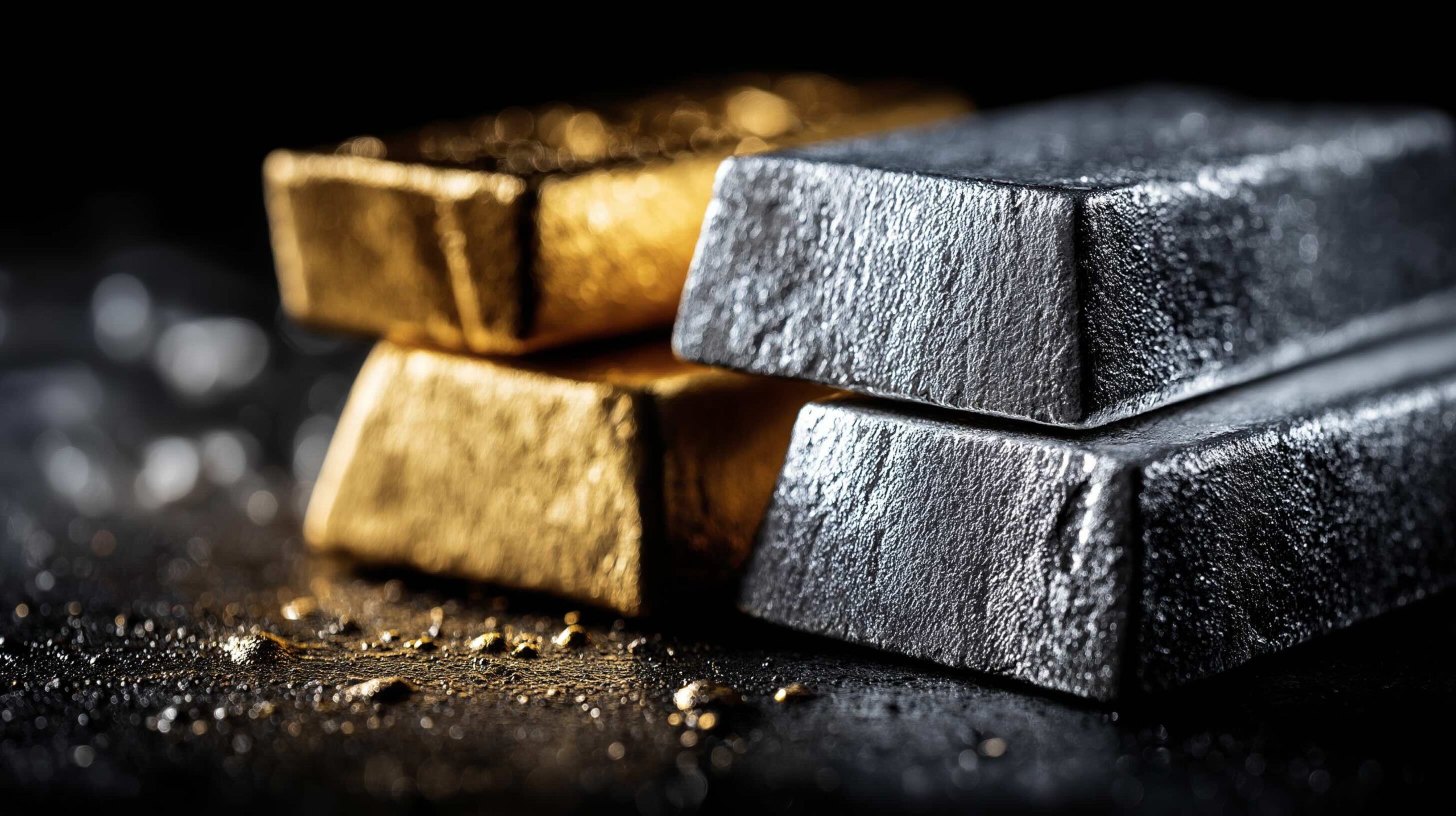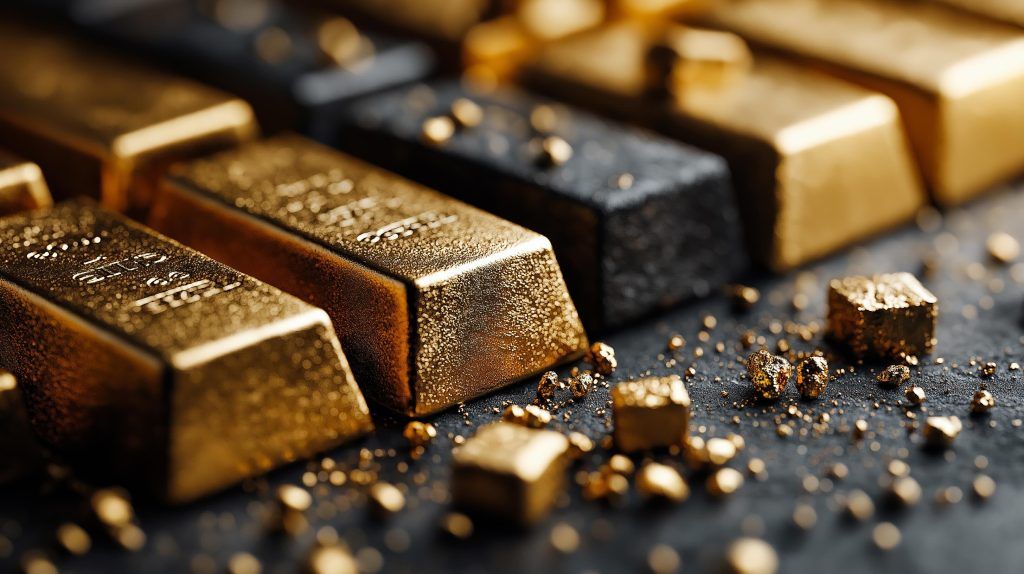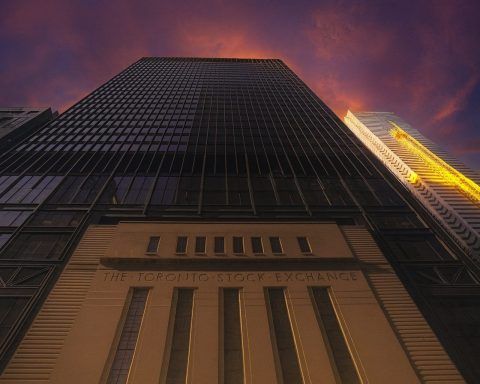- Spot Price (Oct 5, 2025): Silver is trading around $48 per ounce, its highest level since 2011 [1]. This marks a ~60% surge year-to-date, dramatically outpacing gold’s gains [2].
- Near Record High: Silver hit $47.83/oz this week – the loftiest price since May 2011 – just shy of its all-time peak of ~$49.50 (reached in April 2011) [3]. It’s up about 18% in the past month alone, reflecting a blistering rally in late September and early October [4].
- Recent Momentum: In late September, silver broke above $45/oz for the first time in 14 years, extending a rally that’s lifted prices over 55% in 2025, compared to ~43% for gold [5]. This surge accelerated over the past week amid bullish sentiment and safe-haven demand.
- Key Drivers: A “perfect storm” of factors fuels silver’s rise – safe-haven demand on economic and geopolitical jitters, falling real interest rates and a weaker dollar, and robust industrial consumption in solar panels, electronics, and clean energy [6] [7]. Expectations of U.S. Fed rate cuts and a prolonged government shutdown have further boosted precious metals, silver included [8] [9].
- Supply Squeeze: Silver’s supply is struggling to keep up – 2025 marks the fifth consecutive annual deficit in global silver supply [10]. For the past five years, demand has exceeded output by ~800 million ounces, with a 187 Moz deficit projected this year alone [11]. Mine supply is inelastic (much silver is a byproduct of other mining), so output can’t quickly ramp up even as prices rise [12].
- Investor Inflows: Investors are piling in. Silver-backed ETFs saw record inflows of ~95 million ounces in H1 2025, pushing total holdings to near all-time highs (over 1.13 billion oz, worth >$40 billion) [13] [14]. Bullish bets in futures have likewise soared – net long positions on COMEX are over 160% higher than at end-2024 [15] – indicating momentum traders and funds riding the wave.
- Analyst Sentiment: Market analysts remain upbeat yet cautious. Many mainstream forecasts from banks and firms peg silver’s near-term target in the $40–$50 range [16]. Some see $50 as a realistic milestone within months [17], while more bullish experts suggest a decisive break past $50 could ignite a “generational” price jump toward $75 or even $100 if physical shortages intensify [18] [19].
- Other Precious Metals: Gold has also soared – recently topping $3,895/oz for a record high (up ~45% YTD) [20] [21] – but silver’s percentage gain has been larger, narrowing the gold/silver ratio to ~82 (its lowest in a year) [22]. Platinum (~$1,600) is up over 50% this year to 11-year highs [23], and even palladium (+13% YTD) is rebounding. Silver’s dual role as precious and industrial has made it 2025’s standout in the metals complex [24].
Spot silver price (USD/oz) at its highest levels since 2011. The chart shows silver’s 2000s bull run peaking near $49.51 in 2011 and the 2025 surge approaching that historic high. [25]
Silver Nears $50 – Highest Prices in 14 Years
Silver’s price has exploded in 2025, approaching the vaunted $50-per-ounce threshold that has held firm since 1980 and 2011. As of October 5, 2025, spot silver trades around $47.9 per troy ounce [26]. Just a few days ago, it touched $47.83, the loftiest price since May 2011 [27]. This puts the all-time nominal high of $49.51/oz (set in April 2011) within striking distance. In fact, silver is now only a hair’s breadth (roughly 3–4%) below its record high, a dramatic turnaround for a metal that spent much of the last decade languishing in the teens and low $20s.
The current price represents a year-to-date gain of roughly 60%, a stunning rally that has far outshone gold’s performance. To put this in perspective: silver started the year around the low $30s and has added nearly $18 in ten months [28] [29]. Gold, by comparison, is up about 45–47% in 2025, with its own price hitting record highs near $3,900/oz [30] [31]. Silver’s outperformance has pushed the gold–silver ratio (the number of silver ounces equal in value to one ounce of gold) down to ~82, the tightest in a year – signaling silver strengthening relative to gold [32]. This is a reversal from recent years when silver lagged: “Silver is a bit of a catch-up trade, as it had been underperforming gold for several quarters prior to mid-2025,” notes Aakash Doshi, head of gold strategy at State Street [33].
In late September, silver decisively broke out above $45 per ounce – a level it hadn’t seen in 14 years [34]. On September 25, it rallied as high as $45+ amid a “blistering” surge, clocking a 55% rise for the year to date at that point [35]. For context, silver’s surge has outstripped gold’s 43% gain over the same period [36]. The metal’s rapid climb from the mid-$30s in early September to the high-$40s by early October (about an 18% jump in one month [37]) underscores just how quickly sentiment has shifted.
Investors and traders have fresh memories of silver’s historical volatility at such heights. The last two times silver approached $50 – in January 1980 and April 2011 – spectacular booms were followed by brutal busts. In 1980, a speculative frenzy (fueled by the Hunt brothers’ infamous attempt to corner the silver market) briefly sent prices to ~$49.80 before the bubble burst. In 2011, silver spiked to $49.51 amid a commodities boom, only to plunge soon after. These episodes underline that silver can be wildly volatile, prone to boom-and-bust cycles more than its yellow-metal counterpart [38]. As silver now flirts with $50 again, seasoned analysts warn that this psychologically significant ceiling could trigger turbulence – yet a clear breakout above it might also open the floodgates for even sharper gains, due to the lack of technical “overhead” resistance beyond that point [39].
Recent Price Movements and Trends
Over the past weeks and months, silver’s ascent has rapidly accelerated. Early in 2025, silver was steadily climbing on positive fundamentals, but it truly caught fire in the second half. After hovering in the mid-$20s to low-$30s for much of last year and early 2024 [40], the metal picked up momentum as 2025 progressed. By mid-year, silver had hit the high $30s; June 2025 even saw a 13-year high (at the time) when prices briefly exceeded $39/oz [41]. That June rally – the biggest monthly jump since the Reddit-fueled “silver squeeze” of 2021 – put silver up ~25% for the year by mid-year [42].
The real fireworks came in late Q3 2025. September opened around the low $40s and then silver went on a tear. In the final week of September, it smashed through $45. On Oct 1, it reached $47.83, its highest price since 2011 [43], and essentially doubled from its 2024 average price. Over the last 30 days, silver’s price has leapt about 18% [44], an unusually large move for a commodity in such a short span. Each time silver neared a round number milestone ($40, $45, now $48), fresh buying swelled – indicating strong momentum trading.
Several short-term factors contributed to these recent spikes. A notable driver was a flight to safety in late September: U.S. equities stumbled and investors sought refuge in precious metals. This “risk-off” mood, combined with ongoing worries about the U.S. economy’s trajectory, bolstered silver alongside gold [45]. Silver’s 2.6% surge on Sept 25 (above $45) coincided with a selloff in stock markets and a dip in the U.S. dollar [46] [47]. Additionally, technical buying kicked in once silver blew past its previous 2024 highs – traders who had been eyeing the $30s and low $40s piled in as the upward trend strengthened, further propelling the metal.
Notably, silver’s rally in 2025 has been more gradual and structurally supported than the short-lived mania of the 2021 “meme” squeeze. This year’s uptrend has seen consistent higher highs and healthy consolidations, suggesting a more sustainable climb. “It is important to highlight the solid uptrend we have seen so far this year,” remarked Shree Kargutkar, a portfolio manager at Sprott, adding that in his view, “this is just the beginning” of silver’s run [48]. By early October, with prices in the high $40s, market excitement is palpable – yet many participants are also bracing for increased volatility as the $50 mark draws near.
Drivers Behind Silver’s Surge: Safe-Haven and Macro Forces
A confluence of macroeconomic tailwinds and safe-haven demand underpins silver’s 2025 surge. In many ways, silver is riding the same waves lifting gold – fears of economic uncertainty, a shift toward easier monetary policy, and geopolitical tensions – with the added kick of its industrial angle (more on that later). Key macro drivers include:
- Interest Rates & Fed Policy: This year saw a major pivot in expectations for U.S. interest rates. After aggressive hikes in 2022–2023, the Federal Reserve began cutting rates in 2025, and markets anticipate more to come [49]. By October, investors were pricing in additional Fed rate reductions – with a 25 bps cut expected as soon as this month and more by year-end, amid signs of a cooling economy [50]. Lower interest rates boost the appeal of precious metals like silver, which yield no interest. As real yields fall, the “opportunity cost” of holding silver drops, making it more competitive versus bonds or cash [51]. This dynamic has been crucial: “declining real interest rates in the U.S.” are a key tailwind, noted UBS analysts, as they forecast gold (and by extension silver) to continue climbing [52].
- Economic Jitters & Safe Haven Demand: A slew of economic concerns have sent investors into safe havens. In the U.S., a looming government shutdown (which took effect at the start of October) raised fears of economic damage, prompting a flight to safety [53]. Political stalemate and uncertainty about fiscal stability tend to undermine confidence, which benefited precious metals. “The longer the government stays shut down, that’s going to be a steady bullish element for the gold market,” observed Jim Wyckoff of Kitco Metals [54] – and the same logic has been bullish for silver. Conversely, when sporadic progress toward a budget deal appeared, metals would briefly dip, highlighting how sensitive the market is to headline news. Beyond the shutdown, labor market signals added to recession worries: a surprise decline in U.S. private payrolls (ADP report showing –32k jobs in September) reinforced bets on Fed easing and spurred a rally in both gold and silver [55] [56]. In Europe and China, growth concerns and central-bank stimulus measures have likewise made a case for holding hard assets. All of these macro anxieties have enhanced silver’s role as a store of value.
- Inflation and Dollar: Inflation, while cooling from 2022 highs, remains a factor. By 2025, U.S. inflation was moderate but still above target, yet the expectation was that it would continue to slow (e.g. the Fed’s preferred PCE index was anticipated to show easing price growth) [57]. Slower inflation emboldens central banks to be dovish. Meanwhile, the U.S. dollar index has softened at times, partly due to the Fed’s dovish tilt and large U.S. deficits. A weaker dollar makes USD-priced commodities cheaper for foreign buyers, lifting demand for silver globally [58]. Indeed, a depreciating dollar has been cited among the “bullish drivers” for precious metals this year [59]. In addition, some investors are buying silver as an inflation hedge or alternative currency, given concerns that massive fiscal spending and any return to quantitative easing could debase fiat money. Prominent voices have warned about the dollar’s long-term outlook – for example, market commentator Robert Kiyosaki predicted a scenario of extreme Fed money-printing and cited silver (along with gold and Bitcoin) as beneficiaries if “faith in the U.S. dollar…is destroyed” (he envisions silver potentially far above current levels in such a crisis) [60]. While $500/oz silver calls are outliers, they reflect an undercurrent of investor desire for hard assets in an era of fiat uncertainty.
- Geopolitical Tensions: The world has no shortage of geopolitical flashpoints in 2025. The ongoing war in Ukraine, which escalated energy and commodity volatility in recent years, continues to underpin safe-haven flows. More recently, conflict flared in the Middle East, adding a layer of risk-off sentiment in global markets [61]. Such conflicts drive investors toward precious metals as a hedge against uncertainty and potential market disruptions. Silver, like gold, tends to get bid up during crises (sometimes even outperforming in percentage terms during sharp spikes of fear). Additionally, U.S.–China relations remain tense, and trade policies are in focus – interestingly, silver has been caught up in this dynamic too: the metal’s inclusion on a draft U.S. “critical minerals” list sparked speculation that it could face tariffs or export curbs [62]. That prospect of restricted supply helped fuel some speculative buying, as traders contemplated whether government policies might further tighten the physical market. In short, 2025’s geopolitical backdrop – from war fears to trade policies – has consistently stoked demand for safe-haven assets, silver included.
All these macro forces have created a bullish backdrop where investors seek shelter and strategic allocation in precious metals. “Investors are navigating everything from shifting Fed policy to global political developments, and gold is playing its traditional role as a store of value,” says Joseph Cavatoni of the World Gold Council [63]. Silver too is sharing that role, with safe-haven demand layered on top of structural trends. Unlike short-term spikes, this time silver’s rise has been supported by both cyclical events (e.g. rate cuts, crises) and structural shifts like portfolio diversification. Notably, central banks themselves have been massive buyers of gold recently [64], signaling trust in hard assets – and while central banks do not typically stockpile silver, their bullion purchases contribute to positive sentiment across the precious metals space. As long as uncertainty stays elevated and interest rates remain relatively low, these macro conditions should continue to support silver.
Industrial Demand & Supply Crunch: Silver’s Fundamentals
Unlike gold, silver straddles the line between precious metal and industrial commodity, and this dual nature is a key reason behind its strength. On the demand side, roughly 60% of global silver demand comes from industrial uses [65] – everything from electronics to solar panels. In 2025, industrial demand for silver is robust, adding fundamental support to the price rally:
- Green Energy Boom (Solar & EVs): Silver is a critical component in photovoltaic solar cells and in many electrical contacts. The ongoing global transition to renewable energy has created an insatiable appetite for silver in the solar industry. Government incentives and falling costs have solar power installations soaring worldwide, especially in China, the U.S., and India. This means more silver being consumed for solar panels. “Silver has become critically important to the global economy,” notes Sprott’s Kargutkar, highlighting that huge solar demand is a major factor in the current rally [66]. In emerging markets like India, solar expansion is booming – India has become a leading solar market, translating to strong silver import demand for panel production [67]. Beyond solar, silver is also used in electric vehicle (EV) electronics, 5G telecom hardware, and energy storage systems, all high-growth tech sectors in a decarbonizing world. This “green demand” has helped lift silver’s baseline usage markedly in recent years [68] [69].
- Electronics & Tech: Silver’s superior electrical conductivity makes it vital in semiconductors, circuit boards, RFID chips, and a myriad of consumer gadgets. Global electronics manufacturing saw an uptick in 2025 (as supply chain issues eased and new tech product cycles began), thereby boosting silver consumption. Notably, the expansion of data centers and AI computing has been identified as an emerging source of silver demand – high-performance servers and communications infrastructure often rely on silver-coated components for conductivity and thermal management. An analysis highlighted that AI data centers alongside renewables have added to the “robust industrial usage” of silver in 2025 [70]. As the world becomes ever more digital and electrified, silver’s industrial role grows in tandem.
While demand soars, the supply side of silver remains constrained, contributing to a tightening market:
- Mining Supply Limits: Unlike gold, a significant portion of silver is produced as a byproduct of mining other metals (such as copper, lead, and zinc). This means that even if silver prices jump, miners can’t easily ramp up silver output unless base metal production also rises. Silver-specific mines exist (primary silver mines), but new projects are few and take years to develop. Recent data show global silver mine output has been fairly stagnant and not keeping pace with demand growth [71]. This structural inelasticity in supply amplifies price movements: when demand surges, supply cannot quickly respond, so shortages loom. “Multiple reports highlight that silver is running a persistent deficit,” the IG Market Analysis team noted, referring to how total consumption has exceeded annual production consistently in recent years [72] [73]. Indeed, 2025 is projected to mark the fifth straight year that the silver market is in deficit (demand > supply) [74].
- Consecutive Supply Deficits: Over 2018–2022, the world consumed hundreds of millions more ounces of silver than were mined or recycled, drawing down above-ground inventories. The Silver Institute reports that in the past five years, cumulative deficits reached ~800 million ounces – effectively eating up a large chunk of silver stockpiles [75]. In 2023, the deficit was significant, and 2025 is on track for another shortfall of around 187 million ounces [76]. Such deficits are historically unusual (silver had surpluses in the early 2010s) and indicate a fundamental tightening. They have been enabled by selling from existing holdings (e.g. ETFs or government sales) and higher recycling, but these are finite sources. Analysts warn that continuous deficits are “starting to take their toll”, as visible inventories dwindle [77].
- Inventory & Stockpiles: The London Bullion Market Association (LBMA) vaults – a key storage hub for silver – have seen their silver inventories trend lower relative to growing ETF holdings. As of August 2025, LBMA vaults held roughly 792 million ounces of silver, but only ~155 million oz of that is estimated to be “freely available” (the rest is allocated to ETFs and private owners) [78] [79]. At the current pace of ETF demand, available stockpiles could be effectively exhausted within months. If headlines start to scream that the LBMA (or COMEX warehouses) are running low on deliverable silver, it could spark panicked buying and an “explosive rally,” according to market strategist AG Thorson [80]. We’re not at that crisis point yet – in fact, COMEX exchange inventories rose earlier this year as higher prices drew out some holdings (CME silver stocks jumped ~60% to 530 million oz since January) [81]. But that rise might be temporary: those ounces came as investors delivered metal to capitalize on high premiums, and they could be withdrawn just as quickly for industrial use or if owners foresee higher prices. The overall trend remains one of tightening supply.
In summary, strong industrial demand growth meeting constrained supply is a classic recipe for higher prices. Silver’s current rally is not just speculative; it has supportive fundamentals. The world’s push for renewable energy, electrification, and advanced technology ensures structural demand for silver going forward. Meanwhile, years of underinvestment in mining and the nature of silver production mean supply is not easily boosted in the short term. These fundamentals have led insiders to draw parallels with palladium’s story: Palladium saw multi-year deficits last decade due to automotive demand and limited supply, which culminated in a spectacular price spike. “If you look at palladium… we saw multiple years of rising demand while supply was stagnant… the market had not woken up until 2016, when all of a sudden a light bulb went off that we were running out of palladium,” Kargutkar explained, noting that silver’s five years of deficits are now finally sparking that same realization among investors [82] [83].
Investor Flows and Market Momentum: ETFs, Funds & Futures
Investor appetite for silver in 2025 has been voracious, amplifying the price gains fueled by fundamentals. Inflows from both institutional and retail channels indicate that capital is aggressively rotating into the metal:
- Record ETF Inflows: Exchange-traded funds (ETFs) and other silver-backed ETPs (exchange-traded products) have seen unprecedented demand this year. According to the Silver Institute, the first half of 2025 alone saw net inflows of 95 million ounces into silver ETPs, surpassing the total inflows of all 2024 [84] [85]. By June 2025, global silver ETF holdings hit about 1.13 billion ounces, just 7% below their all-time peak (1.21 billion oz in Feb 2021) [86]. These holdings are equivalent to well over a year’s mine supply – a testament to investors’ conviction. In dollar terms, the value of silver held by ETFs climbed above $40 billion for the first time ever in June [87] as prices rose. Nearly half of 2025’s ETF inflow occurred in that month, coinciding with silver’s sharp mid-year rally [88]. This wave of ETF buying has been a critical demand factor, effectively removing large quantities of physical silver from the market (ETFs store metal to back the shares they issue, tightening supply). It also signals that mainstream investors are using silver ETFs to gain exposure – whether as a tactical trade or a longer-term inflation hedge. Notably, silver mining equity ETFs have also attracted huge inflows (over $1.7 billion into silver miner ETFs year-to-date) [89], showing broad investor enthusiasm for the sector.
- Speculative & Hedge Fund Buying: In the futures market, large speculators (hedge funds, commodity trading advisors, etc.) have dramatically increased their net long positions on silver. As of late June, net longs on COMEX were 163% higher than at the end of 2024, reaching their highest level since early 2021 [90]. This means many traders are betting on further upside. Managed money has been chasing momentum – each breakout to a new high prompted funds to add long contracts. The flip side is that short positions (bets against silver) have been squeezed or closed out, which can accelerate price moves. When silver blew past $40 and $45, it likely triggered stop-losses for short sellers and forced additional buying (a mini “short squeeze”), contributing to quick price jumps. The recent drop in the gold–silver ratio also indicates some rotation by macro investors from gold into silver, seeking relatively better value. With sentiment running high, positioning is something to watch: while it supports the rally, a crowded long trade can lead to volatility if everyone tries to exit at once. For now, however, these bullish bets underscore the strong conviction in silver’s uptrend.
- Retail Investment & Coins/Bars: On the retail side, the picture is mixed globally. Demand for physical silver coins and bars surged during past crises (2020 pandemic and 2021 silver squeeze), and in 2025 it remains elevated in some regions. For instance, India’s retail investment in silver has grown, with a 7% year-over-year rise in H1 2025 [91], as Indian buyers take advantage of silver’s investment appeal. In Europe too, bar and coin buying has picked up from the lull of a couple years ago (though not quite back to the highs of 2020–2021) [92]. However, in the U.S., high prices have actually led to some selling back by retail investors – many Americans who bought silver at lower prices are taking profits, and new bar/coin purchases have been softer, leading to an estimated 30% drop in U.S. retail silver demand this year [93]. This suggests that at nearly $50/oz, some small investors consider silver “expensive.” The muted retail hype is actually viewed by some analysts as a positive sign – it implies the rally hasn’t been driven by a frenzy of small buyers, and thus may have more room to run before “euphoric” conditions set in. Google search trends for terms like “buy silver coins” are still relatively low, indicating no widespread mania among the general public yet [94]. Historically, major tops (e.g. 1980, 2011) saw a media buzz and retail rush. The current rally’s quieter public profile could mean more fuel in the tank, as institutional money and informed investors lead the charge.
- Momentum & Technicals: Silver’s strong price chart has undoubtedly attracted trend-following investors. Technical analysis indicates silver broke out of a multi-year base and cleared major resistance levels, which is drawing in further buying. The metal is trading above key moving averages and has formed what some chartists call a “bull flag” or a series of higher lows, all bullish patterns. Trading volumes in silver futures and ETFs have spiked on up-days. There’s also been a spillover from gold’s rally – gold’s steady climb to record highs has kept precious metals in the spotlight, and some traders are rotating profits from gold into silver (seeing silver as undervalued by comparison). Additionally, with gold at ~$3,880 and silver ~$48, the ratio (~80) is still higher than historical norms (in the 2010s, the ratio averaged ~60–70; long-term 20th century average was ~50–60). This has prompted the narrative that silver could have more upside to “catch up” to gold in this bull cycle [95]. Funds that trade the gold/silver ratio have been buyers of silver as the ratio trends downward.
Overall, investment demand has been a major accelerant for silver. The combination of ETF hoarding, speculative longs, and steady (if regionally uneven) coin demand creates a scenario where investors collectively soak up a large share of available silver. When investor demand coincides with the supply deficits mentioned earlier, it creates the potential for scarcity and a feedback loop of higher prices attracting more investment. One caveat: these flows can reverse if market conditions change (for example, if the Fed suddenly turned hawkish or a resolution of political crises reduced safe-haven interest). For now, however, the trend remains strongly in favor of silver, with “big money” positioning for further gains.
News Events Shaping Silver’s Short-Term Moves
Zooming in on the past few days and weeks, several news developments have directly influenced silver prices:
- U.S. Government Shutdown Drama: As September turned to October, the U.S. federal government entered a partial shutdown (due to a budget impasse in Washington). Markets fear that a prolonged shutdown could sap economic growth and delay important data releases. This uncertainty has been bullish for precious metals. Silver, like gold, climbed for seven consecutive weeks leading into early October, in part on these fiscal worries [96]. Every time headlines hinted at progress to end the shutdown, silver would pause or pull back slightly; when gridlock persisted, silver gained. The shutdown essentially reinforced the prospect of an economic drag and more Fed easing (as government workers furloughed and services halted), which in turn supported silver’s appeal. “If they happen to have a surprise weekend agreement to open the government back up, that would probably be a bearish element,” noted analyst Jim Wyckoff [97]. Indeed, traders have one eye on Capitol Hill – until a resolution is found, the political dysfunction serves as a steady tailwind for silver.
- Economic Data Surprises: The first week of October was marked by some notable data (or lack thereof). The all-important U.S. jobs report (non-farm payrolls for September) was postponed due to the shutdown, removing a key piece of information that markets rely on [98]. In its absence, alternative indicators took on greater weight. One such data point was the ADP employment report (private payrolls), which shocked analysts by showing a decline of 32,000 jobs – the first drop in over two years [99]. This weak labor signal sent ripples of anticipation that the Fed’s tightening is indeed slowing the economy and that rate cuts are imminent. Precious metals jumped on the news: gold hit fresh records and silver rallied firmly above $47 [100] [101]. Essentially, soft economic readings are being interpreted as “bad news is good news” for silver, because they increase the likelihood of monetary loosening and a lower dollar. Conversely, when strong data surprises do occur (for example, if a manufacturing or GDP report comes in hot), they can spark brief sell-offs in silver as traders recalibrate Fed expectations. So far, though, the recent trend of data – including a benign inflation outlook and some cooling in hiring – has played into silver bulls’ hands.
- Central Bank Signals: While the Fed has taken a dovish turn, other central banks have also influenced the macro environment. The European Central Bank and Bank of Japan maintained accommodative stances, which weakened the euro and yen earlier in the year – indirectly boosting the dollar until the Fed pivoted. But by late 2025, the general global trend is shifting toward easing. Notably, there’s also leadership uncertainty at the Fed (with a U.S. presidential election next year, there’s speculation about changes at the central bank’s helm) [102]. Treasury Secretary (in this scenario, Scott Bessent) expressed disappointment that Fed Chair Jerome Powell hadn’t clearly charted an aggressive rate-cut path [103]. Such political pressure adds to the sense that monetary policy will stay gold/silver-friendly. Additionally, central banks continue to be big net buyers of gold (adding to reserves globally) – while they don’t buy silver, their gold purchases reflect a pro-bullion sentiment among policymakers, indirectly positive for silver’s narrative [104].
- Geopolitical Flashpoints: Early October brought a flare-up in conflict in the Middle East that rattled markets. Any outbreak of war or escalation (for instance, heightened tensions in the Gulf or a sudden geopolitical shock) tends to spur safe-haven buying. The news of clashes or attacks can cause intraday spikes in gold and silver as investors react. Similarly, developments in the Russia-Ukraine war – such as a major offensive or, conversely, peace talk rumors – have momentarily moved commodity markets. Lately, continued fighting with no resolution in sight has kept a risk premium baked into metal prices. Traders are also closely watching U.S.-China relations, especially regarding trade and technology. In September, the U.S. government’s consideration of export restrictions and tariffs on strategic materials included chatter about silver’s strategic importance [105]. While no concrete policy emerged, the very idea of silver being labeled a critical mineral was enough to boost speculative interest, on the notion that geopolitical competition could constrain supply flows.
- Market Technicals & Psychology: Though not “news events” in the traditional sense, it’s worth noting how market psychology has played out around key price milestones. When silver approached $50 in late September, a lot of media attention ensued – headlines about “Silver’s charge toward $50” abounded [106]. Memories of past peaks resurfaced in commentary, which introduced both excitement and caution. Some short-term traders likely took profits in the high $40s, figuring $50 might be a tough ceiling on the first test. This created a bit of choppiness just below $48–$49 as the market digested gains. However, once these consolidations resolve, any decisive break above $50 could trigger fresh headlines and another wave of momentum buying. The psychological importance of round numbers cannot be overstated – $50 is not only an all-time high but also a long-standing “line in the sand” for silver’s narrative. Market commentary like the article “The Hunt for $50: Silver’s Breakout and the History of a Wild Market” has reminded everyone of how dramatic silver’s moves can be [107]. The piece noted that opposing silver’s momentum can be perilous, and suggested that if $50 is cleared, the lack of overhead resistance could lead to swift price discovery to the upside [108]. In essence, the market is self-aware: participants know this is a critical juncture and are positioning accordingly – some cautiously, others aggressively.
In summary, recent events – from D.C. political theatre to surprises in economic data and global conflicts – have acted as short-term catalysts for silver’s swings. Each development either feeds into the bullish macro narrative or momentarily checks it, but the overarching trend has remained intact. Importantly, none of the potential risk factors (a quick fiscal resolution, a shockingly strong economic report, etc.) has been potent enough to derail silver’s climb for more than a brief moment. The news environment continues to provide more fuel than friction for silver’s bull run.
Quotes and Insights from Market Analysts
Market experts – ranging from commodity strategists and fund managers to analysts at major banks – have been weighing in on silver’s remarkable run. Their insights help illuminate the market sentiment and outlook:
- State Street’s View – Catch-Up Rally: “Silver is a bit of a catch-up trade… it has been underperforming gold for several quarters prior to mid-2025,” observes Aakash Doshi, Global Head of Commodities Strategy at State Street [109]. He points out that silver’s fundamentals finally gained traction and the metal started outperforming gold as 2025 progressed. Doshi also notes that supply growth has lagged demand in recent years, which, along with a tight spot market and speculative momentum, supports the rally [110] [111]. In his analysis, factors like the gold–silver ratio dropping to multi-month lows (~82) signal that silver’s relative value improved, attracting investors who see more upside for the “poor man’s gold.”
- Sprott on Palladium-like Potential:Shree Kargutkar, Senior Portfolio Manager at Sprott Asset Management, draws an interesting parallel: the way palladium skyrocketed ~600% in the late 2010s could be a roadmap for silver [112] [113]. In an interview with Kitco News, he recounted how palladium went from ~$500 in 2016 to over $3,000 by 2021 amid supply deficits, and finally peaked at $3,425 in 2022 [114]. Silver’s setup, he argues, shares similarities – multiple years of deficits and a market only now “waking up” to the shortfall [115]. With silver up ~52% year-to-date by September (at that time) [116], Kargutkar said, “at least in our estimation, this is just the beginning” of the move [117]. He believes investors are recognizing that “we are running out of silver” much as they did with palladium, and this realization can drive a multi-year uptrend. His perspective underscores a very bullish long-term thesis – that silver’s current price may only be a stepping stone if structural deficits persist.
- Kitco Metals (Jim Wyckoff) – Event Risks:Jim Wyckoff, a senior analyst at Kitco, has commented on the impact of U.S. political and economic events on precious metals. He suggests that as long as the U.S. government remains in disarray (e.g. extended shutdown), it’s a “steady bullish element” for metals [118]. Wyckoff cautions that surprise positive developments – like a sudden budget deal or unexpectedly strong economic news – could be “bearish elements” that trigger profit-taking [119]. Essentially, his take is that the balance of risks favors the upside for silver given the current climate, but traders should stay vigilant of headline-driven volatility. This balanced view is common: enjoy the bull run but be aware it’s not a one-way bet.
- World Gold Council (Joseph Cavatoni) – Structural Support: Representing more of the gold side, Joseph Cavatoni of the WGC made a statement applicable to precious metals broadly: “What’s important now is that this safe-haven demand is layered on top of structural allocation trends – meaning gold isn’t just reacting to events, but also gaining traction as a core holding in portfolios.” [120] If we substitute silver alongside gold here, the insight is that institutional investors are not just using silver for a quick trade on fear; they are increasingly viewing it as a strategic asset (perhaps for diversification or long-term hedge). Silver joining gold as a core portfolio component would represent a significant shift, and indeed the strong ETF flows suggest this might be happening.
- UBS and Big Banks – Forecasts: Several big banks updated their precious metals forecasts during this rally. UBS in early October said it expects gold to reach $4,200 in coming months [121]. While they didn’t give a public silver target in that note, if one extrapolates using the gold/silver ratio, it implies silver could be projected to around $50+. Citi and TD Securities have been cited with silver forecasts in the $40–$50 range for 2025 [122]. For instance, TD Securities sees ~$40 by end-2025, while Citi forecasts around $40 in 2026 [123] – a bit conservative relative to current prices (meaning they might revise higher given silver is already near $48). The London Bullion Market Association (LBMA)’s annual survey of analysts had a consensus call of ~$25 for average 2025 price as of early this year, but obviously reality has overshot that; interestingly, an LBMA poll now shows some analysts predicting ~$45 by October 2025 (which turned out accurate) [124]. The variation in bank forecasts shows that while many expected a bullish 2025 for silver, the magnitude has surprised even the experts. It’s a reminder that markets can move faster than predictions.
- Independent Analysts – $50 and Beyond: Outside of banks, independent analysts and investors are making bolder calls. Andrew Hecht, a commodities analyst (writing on Barchart and Yahoo Finance), stated, “I believe silver will trade to the $50 level in 2025, challenging the 2011 and 1980 highs in 2026.” [125] He advocates buying silver on dips, arguing the bullish factors are aligned. Jordan Roy-Byrne, a technical analyst, published a silver “bull analog” chart that also shows a break above $50 within roughly a year on historical patterns [126]. Peter Spina, a well-known silver commentator, has been quoted saying that in a scenario of a real rush for physical supplies, “prices could accelerate to and past $50 an ounce” in coming months [127]. On the extremely bullish end, famed author Robert Kiyosaki envisions $500 silver by 2025 in a doomsday scenario of dollar collapse [128] – though that is far outside consensus and taken with a grain of salt by most investors.
- Crescat Capital – Secular Bull Market: A note from Crescat Capital (a global macro asset manager) suggests “we are likely in the early stages of a new secular bull market” for silver [129]. They see the current breakout as the beginning of a long-term uptrend that could last years. The term “secular bull” implies a multi-year period of generally rising prices, punctuated by corrections but with an upward trajectory. If Crescat’s view is correct, 2025’s surge might be akin to 2009–2011’s phase or the 1978–1980 phase – periods when silver ran up dramatically over a few years.
In aggregate, the analyst community’s tone is optimistic about silver, with many highlighting the metal’s strong fundamentals and favorable macro winds. There is a general acknowledgment that $50 is a critical inflection point: some are virtually certain it will be reached soon, while others are watching how the market behaves if it gets there (will it double-top and retreat, or blast through?). Importantly, even those forecasting moderation (say mid-$30s if things normalize) admit that in the near term the momentum could carry silver higher than “fair value” for a while. On the bullish extreme, visions of $75, $100, or higher are typically predicated on an assumption of severe supply shortage or monetary crisis. For example, AG Thorson’s analysis on FX Empire posits that if the LBMA vaults truly run out of available silver and it makes headlines, a “sharp rally toward $75, or even $100, is entirely plausible,” and looking further ahead he even entertains silver trading in “the hundreds of dollars per ounce” within 5–10 years [130] [131]. These figures are not mainstream forecasts but illustrate the upper tail of bullish scenarios being discussed.
Ultimately, what almost all analysts agree on is that the trend for now is upward, and dips have been buying opportunities. The key will be monitoring the factors that could change that trend – such as Fed policy surprises, a reversal in industrial demand, or excessive speculative froth – none of which seem imminent at this juncture. Until then, the expert consensus is that silver’s bull run has room to run, even as they counsel awareness of volatility around big milestones like $50.
Trends in Silver Futures and ETFs
Delving a bit more into the market mechanics, we can see distinct trends in how silver is traded through futures and ETFs, which in turn influence price behavior:
- Futures Market Structure: The silver futures market (primarily the COMEX in New York) shows a textbook bullish structure known as “backwardation” at times in 2025 – where near-term contracts trade at a premium to longer-dated ones – indicating strong immediate demand for physical silver. This happened sporadically as the spot market got tight and investors were willing to pay up for prompt delivery. It’s a bullish sign because it suggests users or investors are eager to get silver now rather than later. Additionally, the CME data indicating high premiums of futures over London spot earlier in the year encouraged arbitrage: metal was delivered into COMEX warehouses to capture those premiums [132]. That increase in COMEX inventory (mentioned earlier) temporarily alleviated some tightness, but those metal flows can reverse if the incentive wanes. We also see high volatility priced into silver options – as traders anticipate big swings, option premiums have climbed, reflecting the uncertainty (or opportunity) around how far and fast silver might move.
- ETF Holding Trends: The composition of ETF holders is interesting. A significant portion of the 95 Moz inflow in H1 2025 [133] went into a few large funds like the iShares Silver Trust (SLV) – popular with both retail and institutional investors. It appears institutional buying (hedge funds, family offices, etc.) has been a big part of these flows, as many are using ETFs for convenience to get silver exposure without dealing with futures or physical delivery. We can glean that because the sizes of some daily creations in the ETF (tens of millions of ounces at a time) suggest large players at work. Moreover, silver ETFs saw global participation: funds in Europe and Asia also noted inflows, not just U.S.-based ones, signaling a broad-based interest in silver investment. Another trend is that some new silver ETFs have launched or grown (for example, silver miner ETFs, leveraged silver funds, etc.), and their performance – with many up over 50% YTD – is attracting momentum investors. According to ETF.com, U.S.-listed silver mining ETFs are among the best performing funds of 2025, outpacing even the S&P 500 [134]. This performance-chasing could continue if silver breaks $50 and grabs headlines, potentially pulling even more generalist investors into the silver trade via ETFs.
- Trading Volume and Liquidity: Silver’s trading volumes on major exchanges have surged in 2025. On COMEX, daily volumes frequently spiked to multi-year highs on big rally days. High volume on up-days is considered confirming strength – it shows strong hands are active. There have been a few days of notable volatility (e.g., a quick $1–2 pullback amid profit-taking), but each time silver found buyers stepping in. Market liquidity remains decent, although the higher the price goes, the more cash margin is required for futures, which can squeeze out some smaller speculators – something to watch if volatility increases. In London’s OTC market, dealers report tighter spreads and sometimes difficulty sourcing large bars immediately, another anecdotal sign of a taut physical market.
- Short Interest and Potential Squeezes: One narrative that has been floating around is whether silver might experience another “short squeeze” akin to early 2021, when a Reddit-fueled campaign briefly targeted silver shorts. In 2025, the context is different – the rally is fundamentally driven, not a social media frenzy. But if silver clears $50 and keeps running, some large short positions (perhaps held by commodity trade houses or hedgers) could feel the pain. Already, there are reports of certain banks reducing their short hedges in silver to avoid getting caught, given the upside risk. The Commitment of Traders reports indicate that commercial hedgers (producers, users, market makers) still have a net short position (they usually do, as they hedge future production or inventory), but that position is smaller than in previous years’ peaks, suggesting they’re cautious about standing in front of this train. A genuine shortage in the physical market could force anyone short to scramble to cover or deliver into contracts, which in an extreme case can amplify a price spike.
In essence, the market structure in futures and ETFs is reinforcing the bullish trend. Heavy ETF accumulation removes supply from circulation, and bullish positioning in futures reflects/specifies high expectations. There is always a risk that if sentiment shifts these holders could all head for the exits, but right now there’s little sign of that. Instead, each pullback has been shallow and met with new buying. Silver’s 2025 behavior is showing characteristics of a strong bull market: rising prices, rising volumes, eager new buyers, and reluctant sellers. Seasoned traders will recall that such environments can last longer and go further than initially imagined – until some catalyst changes the equation.
Outlook: Will Silver Hit $50 – And What Then?
Looking ahead, the burning question on everyone’s mind is “When (and if) silver will decisively break the $50 barrier?” And subsequently, “What happens next?” Based on current dynamics and forecasts:
- Short-Term (Coming Weeks): Many analysts expect silver to test $50/oz imminently, potentially within the next few weeks if supportive conditions persist. The momentum is strong, and absent a major bearish shock, $50 seems within reach. Market psychology around that level will be crucial. We might see increased volatility – possibly a temporary pullback as some traders take profits at the long-term resistance. However, if buying pressure overwhelms selling, silver could slice through $50. If it closes above that threshold and stays there for a few sessions, it would be a powerful bullish confirmation (a new all-time high on charts), likely inviting even more technical and trend-following buyers. In that scenario, near-term targets of $55 or $60 are not outlandish, considering how quickly silver can move once unleashed. For instance, in January 1980, silver ran up from ~$35 to ~$50 in just weeks; in 2011, it went from ~$30 in February to nearly $50 by April. A breakout rally could see similar rapid percentage moves. Some traders have flagged $54/oz (which would be a 10% move above $49) as an initial extension level, and beyond that $60 (roughly the 1.618 Fibonacci extension of the 2011 high, for the technically-minded).
- Medium-Term (Next 6–12 Months): Assuming silver hits $50, the medium-term outlook bifurcates into a few scenarios:
- Bull Case – Super Spike: If the factors driving silver remain in full force (easy money, strong demand, supply tightness) and if a narrative of physical shortage takes hold, silver could enter a parabolic phase. In this bull-case scenario, we would see prices well above $50. Bullish analysts like AG Thorson and some hedge funds posit that an “exhaustion of available inventories” or any hint of default in delivery could send silver skyrocketing toward $75 or even $100 in 2026 [135] [136]. This would likely require a combination of factors: for example, a major supply event (a mine shutdown or nationalization in a key producing country), or monetary crisis (resurgence of high inflation or loss of confidence in currencies), or an exuberant speculative cycle similar to crypto in 2017 or tech stocks in the 90s, but centered on silver. While not the base case for most, this scenario is not impossible – silver’s history shows it is capable of extraordinary moves under the right conditions.
- Base Case – Sustained Strength: Many industry experts foresee silver stabilizing in a higher range if it crosses $50, rather than running away vertically. That is, silver might oscillate between, say, $40 and $60 over the next year, finding a new equilibrium at a historically high plateau. This would mirror what gold did after breaking its 2011 high – it didn’t immediately double, but it did establish a new floor (gold went from a $1,900 ceiling to treating ~$1,800 as a floor post-breakout). If silver follows suit, $50 could turn from a ceiling to a support level eventually. Under this scenario, expect a lot of back-and-forth trading: silver might overshoot to mid-$50s, then correct to the $45-50 zone, then push higher again as fundamentals justify. The drivers here would be continuation of moderate deficits, decent investment demand, and a macro environment that’s positive but perhaps less dramatic than 2025 (for instance, if the economy stabilizes in 2026 with mild inflation and steady low rates, silver could settle into a range).
- Bear Case – Peak and Retreat: We must acknowledge the possibility that $49 could mark a cyclical peak (even if only temporary) should conditions change. If inflation were to flare forcing central banks to turn hawkish again, or if industrial demand unexpectedly slumps (say, due to a global recession or technological change reducing silver usage), silver could retrace. A controlled U.S. economic soft landing with no further crises might also reduce safe-haven demand. In such a bear-case, silver might pull back to the $30s. In fact, some bank forecasts (World Bank, ANZ, etc.) list silver in the low $30s for 2025/26 [137], implying they think the current prices are overshooting. Historically, silver’s spikes have been followed by 30-50% corrections. So one cannot rule out that after the current excitement, silver consolidates or corrects significantly. However, given the robust fundamentals now, few are predicting a crash all the way back to pre-rally levels (e.g. sub-$25 seems unlikely barring a major deflationary shock).
- Comparative Outlook (Silver vs. Gold): Silver’s trajectory will also depend on gold’s performance. If gold continues its climb toward the $4,000+ area as some predict [138], it will provide a supportive backdrop for silver to follow (with higher beta). The gold:silver ratio could further compress – some foresee it dropping to 70 or even 60 in a strong silver scenario [139]. That implies silver outperforming gold in the next phase. On the flip side, if gold’s rally stalls out around $4,000, silver might also plateau. For other metals, platinum’s breakout (it’s at 11-year highs now) is another supportive factor, as it indicates investor appetite for undervalued precious metals (platinum was undervalued relative to gold, similar to silver’s story). The fact that platinum and silver are both playing “catch-up” lends credence to the idea that these secondary precious metals can sustain higher price regimes alongside gold. Palladium’s decline from its peak might serve as a cautionary tale – after a huge run-up, palladium crashed by more than half when auto demand dynamics shifted. Silver bulls argue silver’s use cases are more diversified and growing, making such a crash less likely in the near future, but it’s something to be mindful of in the longer term.
- External Risks: One wild card for the outlook is if there’s a significant improvement in global stability – e.g., a durable peace in Ukraine, or surprisingly strong economic growth with low inflation (a “Goldilocks” scenario). This could reduce the urgency to hold precious metals, potentially capping silver’s upside. Additionally, any regulatory changes in how investors can access silver (for instance, if authorities concerned about commodity inflation put position limits or raise margins excessively) might dampen speculation. However, there’s no sign of such intervention at the moment; in fact regulators largely dismissed the idea of curbing the 2021 silver squeeze because the market functioned orderly even under strain.
As of October 2025, the sentiment is predominantly bullish, tempered with a dose of realism that markets don’t move in straight lines. A compilation of forecasts by Scottsdale Bullion & Coin found the average predicted silver price for 2025 was $40.90, with most experts clustered in the high $30s to $50 range [140]. But with silver already above those levels, forecasters are undoubtedly revising their targets upward. The high end of surveyed predictions even included $100 or more (though those are outliers) [141] [142]. It’s fair to say that if silver firmly breaks its old record, we are in uncharted territory historically, and the ceiling could be considerably higher than $50 once momentum and new fundamental narratives (like “running out of silver”) take hold.
In conclusion, the price of silver as of early October 2025 is near historic highs, driven by a potent mix of investor zeal, economic undercurrents, and genuine supply-demand tightness. Recent price action shows strong upward momentum, and news catalysts – from Fed policy shifts to geopolitical tensions – continue to favor bullion. Industrial demand provides a solid fundamental floor, while investor flows add rocket fuel. The consensus among many analysts is that silver will likely breach the $50 mark in the near term, an event that would be headline-grabbing given its multi-decade significance. Beyond that, opinions diverge on how far and fast it could climb, but there’s broad agreement that the medium-term backdrop (low rates, robust demand, constrained supply) is supportive for prices to remain elevated relative to previous years.
For investors and the general public, the silver surge of 2025 underscores a classic pattern: when economic uncertainty meets technological demand and constrained supply, a commodity’s value can rise dramatically. Silver has always been known as the “volatile sibling” of gold – prone to sharper spikes and dips. 2025 is proving that true once again, with silver staking its claim as both a refuge in uncertain times and a cornerstone metal for the industries of the future. Whether you’re drawn to it for its investment glimmer or its industrial shine, silver’s journey this year has been remarkable – and the coming chapters, as it flirts with $50 and potentially beyond, could be just as compelling.
Sources: Bloomberg, Kitco News, Reuters, CNBC, MarketWatch and other market reports [143] [144] [145] [146] [147] (see linked references for full details).
References
1. www.reuters.com, 2. www.usagold.com, 3. www.reuters.com, 4. tradingeconomics.com, 5. theedgemalaysia.com, 6. www.usagold.com, 7. www.reuters.com, 8. www.reuters.com, 9. www.reuters.com, 10. www.reuters.com, 11. www.silver-phoenix500.com, 12. www.ig.com, 13. www.mining.com, 14. www.mining.com, 15. www.mining.com, 16. www.sbcgold.com, 17. www.ig.com, 18. www.fxempire.com, 19. www.fxempire.com, 20. www.reuters.com, 21. www.reuters.com, 22. www.reuters.com, 23. theedgemalaysia.com, 24. www.reuters.com, 25. www.reuters.com, 26. www.reuters.com, 27. www.reuters.com, 28. www.ig.com, 29. www.ig.com, 30. www.reuters.com, 31. www.usagold.com, 32. www.reuters.com, 33. www.reuters.com, 34. theedgemalaysia.com, 35. theedgemalaysia.com, 36. theedgemalaysia.com, 37. tradingeconomics.com, 38. www.usagold.com, 39. www.usagold.com, 40. www.sbcgold.com, 41. www.mining.com, 42. www.mining.com, 43. www.reuters.com, 44. tradingeconomics.com, 45. theedgemalaysia.com, 46. theedgemalaysia.com, 47. theedgemalaysia.com, 48. www.silver-phoenix500.com, 49. www.reuters.com, 50. www.reuters.com, 51. www.ig.com, 52. www.reuters.com, 53. www.reuters.com, 54. www.reuters.com, 55. www.usagold.com, 56. www.usagold.com, 57. theedgemalaysia.com, 58. www.ig.com, 59. theedgemalaysia.com, 60. www.sbcgold.com, 61. www.reuters.com, 62. www.reuters.com, 63. www.reuters.com, 64. theedgemalaysia.com, 65. www.reuters.com, 66. www.silver-phoenix500.com, 67. www.silver-phoenix500.com, 68. www.ig.com, 69. www.ig.com, 70. www.usagold.com, 71. www.silver-phoenix500.com, 72. www.ig.com, 73. www.ig.com, 74. www.reuters.com, 75. www.silver-phoenix500.com, 76. www.silver-phoenix500.com, 77. www.silver-phoenix500.com, 78. www.fxempire.com, 79. www.fxempire.com, 80. www.fxempire.com, 81. www.reuters.com, 82. www.silver-phoenix500.com, 83. www.silver-phoenix500.com, 84. www.mining.com, 85. www.mining.com, 86. www.mining.com, 87. www.mining.com, 88. www.mining.com, 89. www.etf.com, 90. www.mining.com, 91. www.mining.com, 92. www.mining.com, 93. www.mining.com, 94. www.fxempire.com, 95. www.reuters.com, 96. www.reuters.com, 97. www.reuters.com, 98. www.reuters.com, 99. www.usagold.com, 100. www.usagold.com, 101. www.usagold.com, 102. theedgemalaysia.com, 103. theedgemalaysia.com, 104. theedgemalaysia.com, 105. www.reuters.com, 106. www.usagold.com, 107. www.usagold.com, 108. www.usagold.com, 109. www.reuters.com, 110. www.reuters.com, 111. www.reuters.com, 112. www.silver-phoenix500.com, 113. www.silver-phoenix500.com, 114. www.silver-phoenix500.com, 115. www.silver-phoenix500.com, 116. www.silver-phoenix500.com, 117. www.silver-phoenix500.com, 118. www.reuters.com, 119. www.reuters.com, 120. www.reuters.com, 121. www.reuters.com, 122. www.sbcgold.com, 123. www.sbcgold.com, 124. www.sbcgold.com, 125. finance.yahoo.com, 126. www.sbcgold.com, 127. www.sbcgold.com, 128. www.sbcgold.com, 129. www.sbcgold.com, 130. www.fxempire.com, 131. www.fxempire.com, 132. www.reuters.com, 133. www.mining.com, 134. m.economictimes.com, 135. www.fxempire.com, 136. www.fxempire.com, 137. www.sbcgold.com, 138. www.reuters.com, 139. www.fxempire.com, 140. www.sbcgold.com, 141. www.sbcgold.com, 142. www.sbcgold.com, 143. www.reuters.com, 144. www.usagold.com, 145. www.reuters.com, 146. theedgemalaysia.com, 147. www.mining.com










